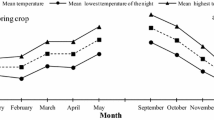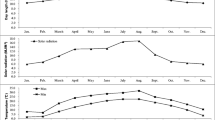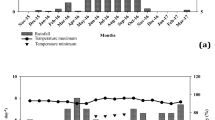Summary
The effect of foliar sprays of 0, 25, 50 and 75 ppm potassium gibberellate (KGA) and 1, 2 and 3 applications were studied on an economically important summer variety of potato (Eslamboli) in a factorial experiment. Three applications of KGA regardless of concentration significantly increased the number of tubers and the total length of main stems over 1 and 2 applications. Soluble solids content of tubers significantly decreased with each unit increase in number of applications regardless of concentration. A combination of 3 applications at 25 ppm caused the largest significant increase in total length of main stems. Mean length of main stems also significantly increased when the concentration, number of applications or their combination were considered. Treated tubers appeared smaller than controls. There were no changes in mean fresh weight of each tuber, dry matter percentage, number of main stems or total yield.
Zusammenfassung
In einem faktoriellen Versuch wurden die Einflüsse von Kalisalz der Gibberellinsäure (KGA) bei Gaben von 0, 25, 50 und 75 ppm und bei 1, 2 und 3 Anwendungen auf die vegetative Entwicklung und die Knollenerzeugung einer ökonomisch wichtigen Sommerkartoffelsorte (Eslamboli) untersucht. Der Versuch wurde als Split-plot mit 4 Wiederholungen angelegt.
Die Knollen wurden am 1. April 1971 ausgepflanzt. Die erste Spritzung wurde 4 Wochen nach dem Auspflanzen, als die Stengel 10–12 cm lang waren, vorgenommen. Die weiteren Spritzungen folgten in je 10 Tagen Abstand. Das vegetative Wachstum wurde alle 10 Tage an den vierten, achten und zwölften Pflanzen in der Reihe der 14 Pflanzen gemessen. Die Knollen wurden am 10. August 1971 geerntet und die notwendigen Messungen daran vorgenommen.
Drei Anwendungen von KGA, gleichgültig welcher Konzentration, erhöhten in signifikanter Weise die Anzahl der Knollen, und die Gesamtlänge der Haupttriebe gegenüber von nur einer oder zwei Anwendungen (Tabelle 1, Abb. 2). Der Gehalt an löslichen Inhaltsstoffen der Knollen verminderte sich signifikant mit jeder zusätzlichen Behandlung ohne Rücksicht auf die Konzentration (Tabelle 1). Die Kombination von 3 KGA-Anwendungen zu 25 ppm brachte die grösste signifikante Zunahme in der Gesamtlänge der Haupttriebe (Tabelle 2). Bei zwei und drei Anwendungen von KGA, gleichgültig welcher Konzentration, nahm die durchschnittliche Länge der Haupttriebe im Vergleich zu einer Behandlung signifikant zu (Tabelle 1, Abb. 3). KGA zu 25–50 ppm, ohne Rücksicht auf die Zahl der Anwendungen, brachte eine signifikante Zunahme der durchschnittlichen Länge der Hauptstengel (Tabelle 3). Die Kombination von 3 Spritzungen mit KGA zu 50 ppm zeitigte die grösste signifikante Zunahme in der durchschnittlichen Länge der Haupttriebe (Tabelle 4). Knollen von behandelten Pflanzen waren kleiner als die der Kontrolle (Abb. 1). Es ergaben sich keine signifikanten Aenderungen in der Anzahl der Haupttriebe, in Prozent der Trockensubstanz der Knollen, im durchschnittlichen Frischgewicht jeder Knolle und im Gesamtertrag der Knollen.
Résumé
Les auteurs ont étudié dans une expérience factorielle les effets de gibbérellate de potassium (KGA) à 0, 25, 50 et 75 ppm et 1, 2 et 3 applications sur le développement végétatif et la production de tubercules d'une variété économiquement importante (Eslamboli). Ils ont utilisé la méthode des blocs avec répartition des parcelles au hasard et 4 répétitions.
La plantation eut lieu le ler avril 1971. La première pulvérisation fut effectuée 4 semaines après la plantation, au moment où la longueur des tiges était de 10–12 cm environ, et les pulvérisations étaient répétées après chaque période de 10 jours. La mesure du développement végétatif a été faite chaque dixième jour sur la quatrième, huitième et douzième plante dans la ligne de 14 plantes. La récolte des tubercules s'est faite le 10 août 1971 et on a effectué sur ceux-ci les mensurations nécessaires.
Trois applications de KGA, indépendamment de la concentration, accroissent significativement le nombre de tubercules et la longueur totale des tiges principales par rapport à 1 ou 2 applications (tableau 1, fig. 2). La teneur des tubercules en éléments solubles diminue significativement avec chaque augmentation du nombre d'applications, indépendamment de la concentration (tableau 1). La combinaison de 3 applications et de la dose de 25 ppm entraîne l'augmentation la plus significative de la longueur totale des tiges principales (tableau 2). Deux et trois applications de KGA indépendamment de la concentration augmentent significativement la longueur moyenne des tiges principales par comparaison avec une application (tableau 1, fig. 3). Le KGA à 25–50 ppm, indépendamment du nombre d'applications, augmente significativement la longueur moyenne des tiges principales (tableau 3). La combinaison ‘3 applications de KGA à 50 ppm’ a provoqué l'accroissement le plus significatif de la longueur moyenne des tiges principales (tableau 4). Les tubercules traités se sont révélés de volume inférieur à ceux des témoins (fig. 1). Aucun changement significatif n'est apparu dans le nombre de tiges principales, le pourcentage de matière sèche des tubercules, le poids moyen frais de chaque tubercule et la production totale de tubercules.
Similar content being viewed by others
References
Bishop, J. C. & H. Timm, 1968. Comparative influence of gibberellic acid and of plant population on distribution of potato tuber size.Am. Potato J. 45: 182–187.
Chapman, H. W., 1958. Tuberization in the potato plant.Physiologia Pl. 11: 215–224.
Choudhuri, H. C. & S. Ghose, 1963. Effect of gibberellic acid on sprouting, growth of internodes, tuber shape and yield in different varieties of potatoes.Eur. Potato J. 6: 160–167.
Claver, F. K., 1960. Effectos del acido giberelico y de la hidrazida maleica sore la tuberizacion de la papa. Phyton 15: 29–35.
Doorenbos, J., 1958. Effect of gibberellic acid on sprouting of potatoes.Neth. J. agric. Sci. 6: 267–270.
Dyson, P. W., 1965. Effects of gibberellic acid and (2-chloroethyl)-trimethyl ammonium chloride on potato growth and development.J. Sci. Fd Agric. 16: 542–549.
Dyson, P. W. & E. C. Humphries, 1966. Modification of growth habit of Majestic potato by growth regulators applied at different times. Ann. appl. Biol. 58: 171–182.
Gregory, L. E., 1956. Some factors for tuberization in the potato plant.Am. J. Bot. 43: 281–288.
Harmey, M. A., M. P. Crowley & P. E. M. Clinch, 1966. The effect of growth regulators on tuberization of cultured stem pieces ofsolanum tuberosum.Eur. Potato J. 9: 146–151.
Hiele, F. J. H. van, 1961. Unsprouted tubers treated with gibberellic acid (GA3).Eur. Potato J. 4: 26–39.
Holmes, J. C., R. W. Lang & A. K. Singh, 1970. The effect of five growth regulators on apical dominance in potato seed tubers and on subsequent tuber production.Potato Res. 13: 342–352.
Humphries, E. C., 1958. The effect of gibberellic acid and kinetin on growth of Majestic potato.Ann. appl. Biol. 46: 346–351.
Kato, T. & H. Ito, 1961. Interrelations between gibberellin and dormancy of potato tuber.Tohoku J. agric. Res. 12: 1–8.
Lascarides, D. L., 1967. Shortening the dormant period of spring-grown seed potatoes for mid-summer planting.Eur. Potato J. 10: 100–107.
Lindblom, H., 1967. Gibberellin treatment of seed potatoes.Landtmannen 78; 9: 25–26.
Lippert, L. F., L. Rappaport & H. Timm, 1958. Systemic induction of sprouting in white potatoes by foliar applications of gibberellin.Pl. Physiol. 33: 132–133.
Lovell, P. H. & A. Booth, 1967. Effects of gibberellic acid on growth, tuber formation and carbohydrate distribution inSolanum tuberosum.New Phytol. 66: 525–537.
Macleod, D. J. & J. L. Howatt, 1958. The effect of gibberellin compounds on the shape of potato tubers.Am. Potato J. 35: 596–597.
Madec, P., 1963. Tuber-forming substances in the potato. In: J. D. Ivins & F. L. Milthorpe (Ed.), The growth of the potato. Butterworth, London, p. 121–130.
Madec, P. & P. Perennec, 1969. Breaking of dormancy of potato tubers at different ages: action of rindite, gibberellin and eye excision.Eur. Potato J. 12: 96–115.
Morgan, D. G. & G. C. Mees, 1958. Gibberellic acid and the growth of crop plants.J. agric. Sci. 50: 49–59.
Okazawa, Y., 1959. Studies on the occurrence of natural gibberellin and its effects on the tuber formation of potato plants.Proc. Crop Sci. Soc. Jap. 28: 129–133.
Racca, R. W. & R. Tizio, 1968. A preliminary study of changes in the content of gibberellin-like substances in potato plants in relation to the tuberization mechanism.Eur. Potato J. 11: 213–220.
Rappaport, L., L. F. Lippert & H. Timm, 1957. Sprouting, plant growth, and tuber production as affected by chemical treatment of white potato seed pieces. I. Breaking the rest period with gibberellic acid.Am. Potato J. 34: 254–260.
Rappaport, L., H. Timm & L. F. Lippert, 1958. Gibberellin on white potatoes.Calif. Agric. 12: 4–5, 14.
Rowberry, R. G. & G. R. Johnston, 1964. A note on seed and foliar applications of ‘Gibrel’ to Huron potatoes.Am. Potato J. 41: 212–214.
Slomnicki, I. & I. Rylski, 1964. Effect of cutting and gibberellin treatment on autumn-grown seed potatoes for spring planting.Eur. Potato J. 7: 184–192.
Smeltzer, G. G. & D. C. Mackay, 1963. The influence of gibberellic acid seed treatment and seed spacing on yield and tuber size of potatoes.Am. Potato J. 40: 377–380.
Timm, H., L. Rappaport, J. C. Bishop & B. J. Hoyle, 1960. Sprouting, plant growth and tuber production as affected by chemical treatment of white potato seed pieces. II. Effect of temperature and time of treatment with gibberellic acid.Am. Potato J. 37: 357–365.
Timm, H., L. Rappaport, J. C. Bishop & B. J. Hoyle, 1962. Sprouting, plant growth, and tuber production as affected by chemical treatment of white potato seed pieces. II. Effect of temperature and time of treatment with gibberellic acid.Am. Potato J. 37: 357–365.
Timm, H., L. Rappaport, J. C. Bishop & B. J. Hoyle, 1962. Sprouting, plant growth, and tuber production as affected by chemical treatment of white potato seed pieces. IV. Responses of dormant and sprouted seed potatoes to gibberellic acid.Am. Potato J. 39: 107–115.
Verma, S. C., 1966. Induction of stolons and tubers by the leaves of the potato (Solanum tuberosum).Eur. Potato J. 9: 259–260.
Wheeler, A. W. & E. C. Humphries, 1963. Effect of gibberellic acid on growth, gibberellin content, and chlorophyll content of leaves of potato (Solanum tuberosum).J. exp. Bot. 14: 132–136.
Author information
Authors and Affiliations
Rights and permissions
About this article
Cite this article
Badizadegan, M., Tafazoli, E. & Kheradnam, M. The effect of potassium gibberellate on vegetative growth and tuber production ofEslamboli potatoes. Potato Res 16, 89–98 (1973). https://doi.org/10.1007/BF02360612
Accepted:
Issue Date:
DOI: https://doi.org/10.1007/BF02360612




